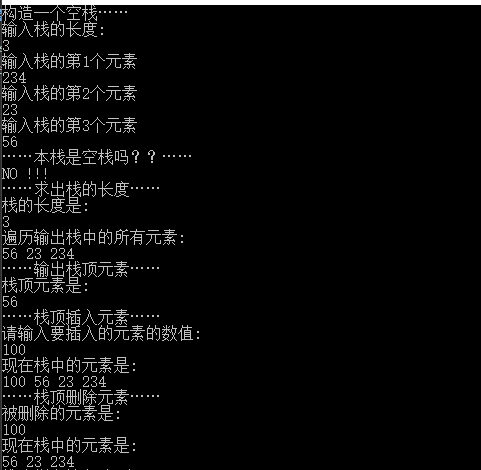順序棧的九種基本操作和實現(資料結構C語言版清華大學嚴蔚敏)
阿新 • • 發佈:2019-01-10
棧是僅限定在表尾進行插入和刪除操作的線性表,在嚴蔚敏版的C語言版的資料結構中共定義了九種棧的基本操作;分別是構造 銷燬 清空 棧長 棧頂 插入 刪除 遍歷。下面就是程式碼實現:
標頭檔案和巨集定義(儲存為constant.h)
#include<iostream>
#include<string.h>
#include<stdlib.h>
#include<malloc.h>
using namespace std;
#define TRUE 1
#define FALSE 0
#define OK 1
#define ERROR 0 棧的順序結構表示
#include"constant.h"
typedef struct
{
ElemType *base;
ElemType *top;
int stacksize;
}SqStack;九種基本操作
1.構造一個空棧
Status InitStack(SqStack &S)
{
S.base 2.銷燬棧
Status DestroyStack(SqStack &S)
{
S.top = NULL;
S.stacksize = 0;
free(S.base);
return OK;
}3.清空棧
Status ClearStack(SqStack &S)
{
S.top = S.base;
return OK;
}4.判斷棧是否為空棧
Status StackEmpty(SqStack S)
{
if (S.top == S.base)
return ERROR;
else
return TRUE;
}5.求棧的長度
Status StackLength(SqStack S)
{
if (S.top == S.base)
return FALSE;
else
return (S.top - S.base);//也可以直接返回S.top - S.base
}6.求棧頂元素
Status GetTop(SqStack S, ElemType &e)
{
if (S.top == S.base)
return FALSE;
else
e = *(S.top - 1);
return e;
}7.棧頂插入元素
Status Push(SqStack &S, ElemType &e)
{
if (S.top - S.base >= STACK_INIT_SIZE)
{
S.base = (ElemType *)realloc(S.base, (S.stacksize + STACKINCREMENT) * sizeof(ElemType));
if (!S.base)
{
return false;
}
S.top = S.base + STACK_INIT_SIZE;//棧底地址可能改變,重新定位棧頂元素
S.stacksize = S.stacksize + STACKINCREMENT;
}
*S.top = e;
S.top++;
return OK;
}8.刪除棧頂元素
Status Pop(SqStack &S, ElemType &e)
{
if (S.top == S.base)
return ERROR;
else
{
S.top--;
e = *S.top;//說明:此處容易使人迷惑,實際上此元素並沒真正刪除,仍在S.top中,但是如果插入元素,就會被更新,就像是刪除了一樣
return e;
}
}
9.遍歷棧
Status StackTraverse(SqStack S)
{
if (S.base == NULL)
return ERROR;
if (S.top == S.base)
cout << "棧中沒有元素" << endl;
ElemType *p;
p = S.top;
while (p > S.base)
{
p--;
cout << *p << " ";
}
return OK;
}
基本操作到此結束,下面主函式中檢驗
主函式:
// 棧的九種表示和實現.cpp : 定義控制檯應用程式的入口點。
//
#include "stdafx.h"
#include "header.h"
int main()
{
SqStack S;
cout << "構造一個空棧……" << endl;
InitStack(S);
int i,n ;
cout << "輸入棧的長度:" << endl;
cin >> n;
for (i = 1; i <= n; i++)
{
cout << "輸入棧的第" << i << "個元素" << endl;
++S.top;
cin >> *(S.top-1);
}
cout << "……本棧是空棧嗎??……" << endl;
if (StackEmpty(S) == 1)
cout << "NO !!!" << endl;
else
cout << "YES !!!" << endl;
cout << "……求出棧的長度……" << endl;
int m;
m = StackLength(S);
cout << "棧的長度是:" << endl;
cout << m << endl;
cout << "遍歷輸出棧中的所有元素:" << endl;
StackTraverse(S);
cout << endl;
cout << "……輸出棧頂元素……" << endl;
int e;
e = GetTop(S, e);
cout << "棧頂元素是:" << endl;
cout << e << endl;
cout << "……棧頂插入元素……" << endl;
cout << "請輸入要插入的元素的數值:" << endl;
cin >> e;
Push(S,e);
cout << "現在棧中的元素是:" << endl;
StackTraverse(S);
cout << endl;
cout << "……棧頂刪除元素……" << endl;
e = Pop(S,e);
cout << "被刪除的元素是:" << endl;
cout << e << endl;
cout << "現在棧中的元素是:" << endl;
StackTraverse(S);
cout << endl;
cout << "……清空棧……" << endl;
ClearStack(S);
cout << "現在棧中的元素是:" << endl;
StackTraverse(S);
cout << "……銷燬棧……" << endl;
if(DestroyStack(S)==1)
cout << "銷燬棧成功" << endl;
else
cout << "銷燬棧失敗" << endl;
cout << "恭喜您成功完成所有的功能,畢竟您那麼帥!!!" << endl;
return 0;
}
接下來是操作結果:


